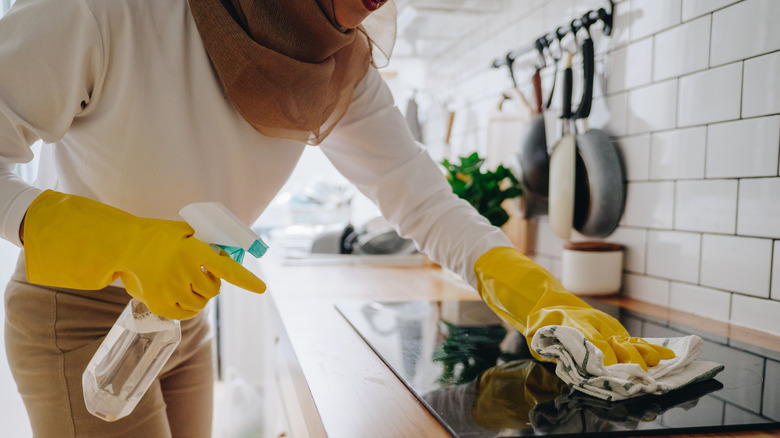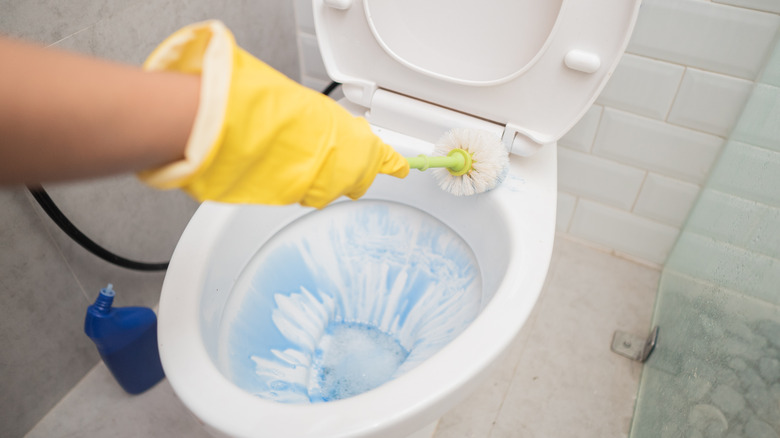Do You Actually Need To Clean Your Cleaning Tools?
When you take your prized arsenal of cleaning tools out of the cupboard, you should be filled with pride. Every scrub brush, sponge, and dusting cloth is essential to keeping your home clean. But have you ever given much thought to whether your cleaning tools might need a little TLC themselves? Does it actually impact how well they can clean other messes?
The answer is a resounding yes and yes. You need to consistently clean and even replace some tools so they can actually clean your home, rather than just spreading dirt around. This is especially important when it comes to brushes and sponges, which can easily hold onto bacteria if not sanitized and cleaned properly. And that's not great if you're using them in your messiest, most germ-prone rooms (hello, bathroom). But how often should these tools be in the regular cleaning rotation, and when is it time to replace them altogether? That really depends on the specific tool and what you usually use it for.
Before we get into the ins and outs of how often tools should be cleaned and how to clean them, it's important to note that you should avoid cross-contaminating brushes and sponges from the bathroom to the kitchen. Consider wrapping a piece of tape around the handle to mark that a brush is only to be used in the bathroom, or buying multiple colors of brushes to help keep it straight.
Bathroom tools should be sanitized frequently
Now, of course, cleaning the bathroom is a necessary evil, and prone to lots of germs and ick. So the toilet brush you're using needs to be sanitized and washed after every use. Do not allow the brush to come in direct contact with any feces during cleaning, as that's one of the major culprits of bacteria growth. Ensure that the brush is free of any bits and then fill the toilet brush holder with hot, soapy water. Twirl it around a few times and then dump the water out, then repeat with hot water and bleach. Allow the brush to dry outside of the holder completely before putting it back in, and wipe the holder dry. Pro tip: just sandwich the toilet brush between the toilet rim and seat so it dries directly into the toilet bowl. You should replace these tools about every six months, and if you find yourself getting too much growth with a synthetic bristle brush, opt for a silicone one.
When it comes to cleaning rags, we recommend avoiding reusing rags in between sanitization cycles; that means a fresh one each day because these are magnets for bacteria and growth. Allow them to dry fully before tossing them in a laundry bin to prevent mold and mildew. Just save the rags up for a weekly wash one day ahead of cleaning day to limit batches, and be sure to use a hot water cycle to sanitize them.
Hold high standards in the kitchen
The kitchen is a sacred place, in our opinion. The cliche that it's the heart of the home is the cliche for a reason. So you should keep the tools in it extremely clean. Now, you probably already know that sponges can be a menace to kitchen cleanliness. They absorb water, yes, but they also have a hard time letting water out, which creates a breeding ground for bacteria. To extend the life of your sponges, wash them in the microwave by putting a thoroughly wet sponge in for one minute, then after it cools, wring it out in the sink. But this trick will only get you so far; you should still replace sponges about every two weeks, well before they start smelling or crumbling.
And while kitchen dish brushes aren't free from these issues, many have a distinct advantage: replaceable brush heads. That means that you can alternate brushes when one is out of commission, and just replace the head instead of the entire plastic handle every few weeks. If you notice that a brush head has a buildup of grease or food particles, pop it in the dishwasher and opt for a sanitization cycle. Side note: be sure to clean that sink frequently too; cleaning dishes in dirty dishwater isn't actually cleaning them.


